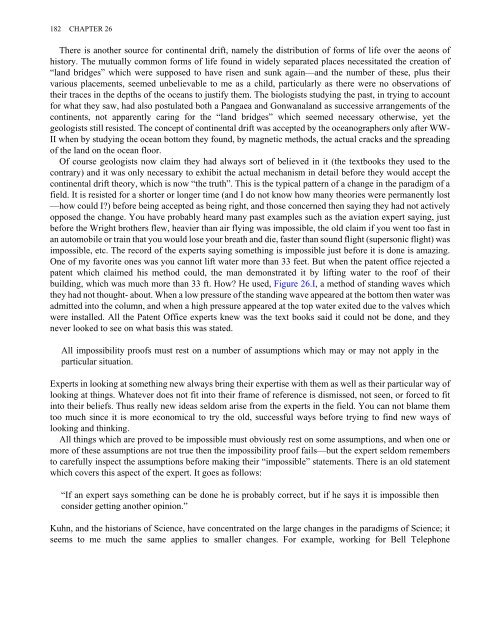hamming
hamming
hamming
Create successful ePaper yourself
Turn your PDF publications into a flip-book with our unique Google optimized e-Paper software.
182 CHAPTER 26There is another source for continental drift, namely the distribution of forms of life over the aeons ofhistory. The mutually common forms of life found in widely separated places necessitated the creation of“land bridges” which were supposed to have risen and sunk again—and the number of these, plus theirvarious placements, seemed unbelievable to me as a child, particularly as there were no observations oftheir traces in the depths of the oceans to justify them. The biologists studying the past, in trying to accountfor what they saw, had also postulated both a Pangaea and Gonwanaland as successive arrangements of thecontinents, not apparently caring for the “land bridges” which seemed necessary otherwise, yet thegeologists still resisted. The concept of continental drift was accepted by the oceanographers only after WW-II when by studying the ocean bottom they found, by magnetic methods, the actual cracks and the spreadingof the land on the ocean floor.Of course geologists now claim they had always sort of believed in it (the textbooks they used to thecontrary) and it was only necessary to exhibit the actual mechanism in detail before they would accept thecontinental drift theory, which is now “the truth”. This is the typical pattern of a change in the paradigm of afield. It is resisted for a shorter or longer time (and I do not know how many theories were permanently lost—how could I?) before being accepted as being right, and those concerned then saying they had not activelyopposed the change. You have probably heard many past examples such as the aviation expert saying, justbefore the Wright brothers flew, heavier than air flying was impossible, the old claim if you went too fast inan automobile or train that you would lose your breath and die, faster than sound flight (supersonic flight) wasimpossible, etc. The record of the experts saying something is impossible just before it is done is amazing.One of my favorite ones was you cannot lift water more than 33 feet. But when the patent office rejected apatent which claimed his method could, the man demonstrated it by lifting water to the roof of theirbuilding, which was much more than 33 ft. How? He used, Figure 26.I, a method of standing waves whichthey had not thought- about. When a low pressure of the standing wave appeared at the bottom then water wasadmitted into the column, and when a high pressure appeared at the top water exited due to the valves whichwere installed. All the Patent Office experts knew was the text books said it could not be done, and theynever looked to see on what basis this was stated.All impossibility proofs must rest on a number of assumptions which may or may not apply in theparticular situation.Experts in looking at something new always bring their expertise with them as well as their particular way oflooking at things. Whatever does not fit into their frame of reference is dismissed, not seen, or forced to fitinto their beliefs. Thus really new ideas seldom arise from the experts in the field. You can not blame themtoo much since it is more economical to try the old, successful ways before trying to find new ways oflooking and thinking.All things which are proved to be impossible must obviously rest on some assumptions, and when one ormore of these assumptions are not true then the impossibility proof fails—but the expert seldom remembersto carefully inspect the assumptions before making their “impossible” statements. There is an old statementwhich covers this aspect of the expert. It goes as follows:“If an expert says something can be done he is probably correct, but if he says it is impossible thenconsider getting another opinion.”Kuhn, and the historians of Science, have concentrated on the large changes in the paradigms of Science; itseems to me much the same applies to smaller changes. For example, working for Bell Telephone


